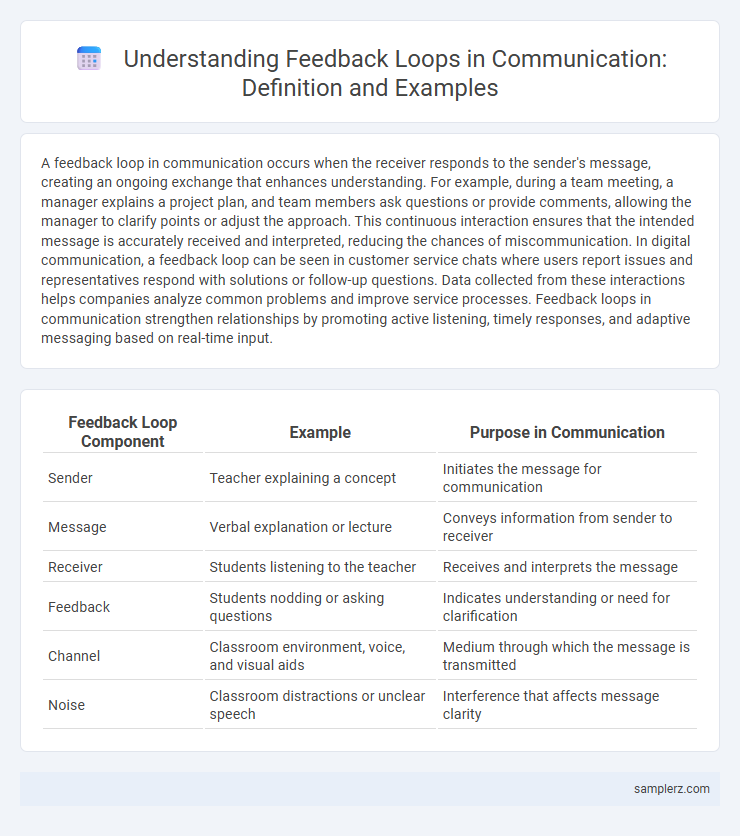A feedback loop in communication occurs when the receiver responds to the sender's message, creating an ongoing exchange that enhances understanding. For example, during a team meeting, a manager explains a project plan, and team members ask questions or provide comments, allowing the manager to clarify points or adjust the approach. This continuous interaction ensures that the intended message is accurately received and interpreted, reducing the chances of miscommunication. In digital communication, a feedback loop can be seen in customer service chats where users report issues and representatives respond with solutions or follow-up questions. Data collected from these interactions helps companies analyze common problems and improve service processes. Feedback loops in communication strengthen relationships by promoting active listening, timely responses, and adaptive messaging based on real-time input.
Table of Comparison
| Feedback Loop Component | Example | Purpose in Communication |
|---|---|---|
| Sender | Teacher explaining a concept | Initiates the message for communication |
| Message | Verbal explanation or lecture | Conveys information from sender to receiver |
| Receiver | Students listening to the teacher | Receives and interprets the message |
| Feedback | Students nodding or asking questions | Indicates understanding or need for clarification |
| Channel | Classroom environment, voice, and visual aids | Medium through which the message is transmitted |
| Noise | Classroom distractions or unclear speech | Interference that affects message clarity |
Understanding Feedback Loops in Communication
Understanding feedback loops in communication is essential for effective interaction, where the sender transmits a message and the receiver responds, creating a continuous cycle of information exchange. This loop enables the sender to assess whether the message was interpreted correctly and make necessary adjustments to improve clarity. Feedback loops enhance mutual understanding, minimize miscommunication, and foster more dynamic and responsive conversations.
The Role of Feedback in Effective Messaging
Feedback plays a crucial role in effective messaging by enabling the sender to understand how their message is received and interpreted by the receiver. In a communication feedback loop, responses such as verbal comments, non-verbal cues, or follow-up questions provide essential information that helps refine and clarify the message. This continuous interaction ensures accuracy, reduces misunderstandings, and enhances mutual understanding between communicators.
Real-Life Examples of Communication Feedback Loops
In customer service, a feedback loop occurs when customers provide reviews after interacting with a support agent, allowing companies to improve their responses and training programs. In team meetings, participants share ideas and reactions in real time, enabling immediate adjustments to project plans or communication strategies. Social media platforms facilitate continuous feedback loops by allowing users to comment, share, and react, influencing content creators' future posts and engagement approaches.
Feedback Loops in Interpersonal Communication
Feedback loops in interpersonal communication occur when a speaker's message is immediately received and responded to by the listener, creating an interactive exchange that clarifies understanding and adjusts the message accordingly. Nonverbal cues like facial expressions, gestures, and tone of voice provide immediate feedback, influencing the ongoing dialogue and emotional connection between participants. This continuous exchange enhances mutual comprehension and strengthens relationships by ensuring both parties remain engaged and responsive throughout the conversation.
Organizational Feedback Loop Scenarios
In organizational communication, feedback loops are essential for ensuring message clarity and operational efficiency, such as when a manager sends performance guidelines to employees who then provide feedback through surveys or team meetings, allowing adjustments to strategies. Another example includes customer support teams receiving client complaints and conveying this information back to product development, facilitating continuous improvement. These iterative exchanges create dynamic feedback loops that enhance collaboration, decision-making, and overall organizational performance.
Digital Communication and Instant Feedback Loops
Digital communication platforms like social media and messaging apps enable instant feedback loops by allowing participants to exchange messages in real time. This immediacy facilitates continuous adjustments and responses, enhancing clarity and mutual understanding. Instant feedback loops optimize communication efficiency by reducing delays and enabling dynamic interaction.
Feedback Loops in Customer Service Interactions
Effective feedback loops in customer service interactions involve real-time responses where customers provide input and agents adjust solutions promptly, enhancing satisfaction. Utilizing tools like surveys, chatbots, and follow-up emails captures continuous customer feedback, enabling service improvement and personalized communication. This dynamic exchange fosters trust and loyalty by addressing concerns swiftly and refining service quality based on direct customer insights.
Constructive Feedback in Team Communication
Constructive feedback in team communication exemplifies an effective feedback loop by encouraging open dialogue and continuous improvement. Team members share specific observations and actionable suggestions, fostering mutual understanding and growth. This reciprocal exchange helps align goals, resolve misunderstandings, and enhance overall team performance.
Improving Communication Through Active Feedback
Active feedback in communication creates a continuous feedback loop where the sender receives immediate responses, enabling real-time clarification and adjustment of messages. This process enhances understanding by encouraging listeners to ask questions and provide constructive comments, reducing misinterpretations and increasing engagement. Implementing active feedback mechanisms improves communication effectiveness in professional and personal interactions by fostering open dialogue and mutual comprehension.
Measuring the Impact of Feedback Loops
Measuring the impact of feedback loops in communication involves evaluating metrics such as response time, message clarity, and behavioral changes to ensure effective information exchange. Analyzing quantitative data like customer satisfaction scores and engagement rates helps identify areas for improvement in communication strategies. Continuous monitoring of feedback loops drives enhanced interaction quality and strengthens organizational communication efficiency.

example of feedback loop in communication Infographic
 samplerz.com
samplerz.com